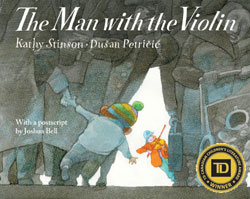“Babysitting Helen”
When I was introduced to teen writers at an event in Guelph last year, one of the participants said, “Kathy Stinson! Did you write “Babysitting Helen“?” It’s not the ending of the question ‘Did you write…?’ that I’m used to hearing!

The girl had read the story in her grade nine English class – probably in Crossroads, the anthology published by Gage. It was reprinted again this year in a grade ten anthology published by Houghton Mifflin. (At least, if it hasn’t been published yet, I expect it soon will be, since rights have now been paid for.)
This will be the fourth book in which “Babysitting Helen” will appear with a print run this time of over 1,000,000 copies. Imagine! Maybe “Babysitting Helen” will become the default ending to the ‘Did you write…?’ question I get asked.
Oh, and just in case you’re wondering. I did write Red is Best, but no I did not write Goodnight Moon. (I wish.)
Share this post:
Kathy Stinson is the author of the classic Red Is Best and the award-winning The Man with the Violin. Her wide range of titles includes picture books, non-fiction, young adult fiction, historical fiction, horror, biography, series books, and short stories. She has met with her readers in every province and territory of Canada, in the United States, Britain, Liberia, and Korea. She lives in a small town in Ontario.








It will actually be the fourth book, if you count the Norwegian textbook! 🙂
Yes, fourth.
Hmm. I wonder why I haven't seen the Houghton Mifflin version yet.
Maybe I meant to say 5th.
Right, 5th!
I'm not sure if I forgot to count the Norwegian textbook reprint, or the original version published in the Thistledown Press anthology, Takes. (It's good I can write better than I can count.) 🙂
I'm analyzing this story and was holding you could help me: what are the themes of this story and what was your intent in writing it?
Thanks I love your work!
Hi Mary. Always nice to hear from a reader who loves my work. 🙂
I'm not sure what to say about themes in "Babysitting Helen". I suppose I think what themes a reader finds in a story depends in part on what they bring to it in terms of their own personal experiences.
As to my intent in writing it? I guess I was just taken by an image that stuck in my head after hearing my teenage daughter describe what happened when she kept an elderly neighbour with Alzheimer's company one evening, so the woman's daughter could take a break. My daughter, who like Trish thought her charge would be sleeping all evening, plunked out a tune on the piano at one point in the evening, and our elderly neighbour, whose name really was Helen, responded by doing a little dance. And I decided it would be fun to see if I could build a story around that image.
Did I fulfill my intention to have some fun exploring this possibility? Yes. And of course I'm delighted that all these years later, you (and other people all across Canada) are still reading the result!
All best, Mary.
What is the significance of Helen telling Trish she lives at the bottom of the garden? Does it have a deeper meaning?
Sorry it’s taken me a while to respond to your question, Vanessa. There was a glitch in the system for a while that didn’t let me know when someone had commented on a post. “You live in the bottom of the garden, don’t you,” are the exact words I stole from the mouth of a woman I used to know, on whom the character of Helen in this story is based. It’s always a treat for me to hear readers’ thoughts about stories I write, so if you (or your classmates, if you were reading the story in school) read anything into Helen’s saying this to Trish, I hope you’ll let me know!